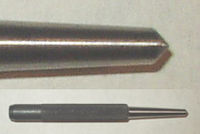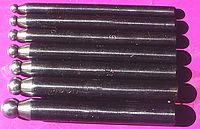- Punch (tool)
-
For punches used in punch presses, see Punching.
A punch is a hard metal rod with a shaped tip at one end and a blunt butt end at the other, which is usually struck by a hammer. Punches are used to drive objects, such as nails, or to form an impression of the tip on a workpiece. Decorative punches may also be used to create a pattern or even form an image.
Contents
Nail or pin
A nail punch, also called a nail set, is used to drive the head of a nail flush with or below a surface. A pin punch is a similar tool used to drive pins for affixing a fixture to a rotating shaft. Nail and pin punches have a body by which the punch is held, with a flat ended cylindrical section whose diameter suits the object to be driven.
Center
A center punch is used to mark the center of a point. It is usually used to mark the center of a hole when drilling holes. A drill bit has the tendency to "wander" if it does not start in a recess. A center punch forms a large enough dimple to "guide" the tip of the drill bit.[1] When drilling larger holes, and the web of the drill is wider than the indentation produced by a center punch, the drilling of a pilot hole is usually needed.
An automatic center punch operates without the need for a hammer.
Prick
A prick punch is similar to a center punch but used for marking out. It has a sharper angled tip to produce a narrower and deeper point. The mark can then be enlarged with a center punch for drilling.[1]
Transfer
A transfer punch is a punch (usually in an index set) of a specific outer diameter that is non-tapered and extends the entire length of the punch (except for the tip). It is used to tightly fit the tolerances of an existing hole and, when struck, precisely transfer the center of that hole to another surface. It can be used, for example, to duplicate the hole patterns in a part, or precisely set locations for threaded holes (created by drilling and tapping) to bolt an object to a surface.
Doming
A doming punch is used in conjunction with a doming block to make spheres or hemispheres out of sheets of metal. The punch is generally made of tool steel, but can be made of wood. They come in a number of different sizes, the punch size determining what size the finished product will be.
Drift
Main article: Drift pinA drift "punch" is misleadingly named; it is not used as a punch in the traditional sense of the term. A drift punch, or drift pin, is used as an aid in aligning bolt or rivet holes prior to inserting a fastener. A drift punch is constructed as a tapered rod, with the hammer acting on the large end of the taper. The tapered end of a drift punch is placed into the semi-aligned bolt holes of two separate components, and then driven into the hole. As it is driven in, the taper forces the two components into alignment, allowing for easy insertion of the fastener. Unlike most punches, force is never (and should never be) applied to the tip, or end of a drift pin.
Decorative
Punches with a decorative motif have been used to create patterns or images on metals and various other materials, notably leather. In goldsmithing, bookbinding and armour-making the technique is called pointillé. In printmaking punches were used to create most of the image in the plates for printing metalcuts.
Letter
Also known as letter stamps or number stamps. These are used to emboss the impression of a letter or number into a workpiece. They are most common in the reverse image, this allows the end result to be immediately readable, however they may be made as a positive image. This is essential in the case of die or mold making and ensures that the finished product will be readable, as a die is a negative image.
Tablet press
These punches are a part of tablet press. Unlike most punches, tablet press punches have a concave ending in the shape of the desired tablet. There are the lower and the upper punches to compress the powder in between.
See also
References
- ^ a b Fournier, Ron; Fournier, Sue (1989), Sheet metal handbook, HPBooks, pp. 21–22, ISBN 9780895867575, http://books.google.com/books?id=ViUmhImu630C&pg=PA21
Types of tools Cleaning tools Broom · Brush · Feather duster · Floor buffer · Hataki · Ice resurfacer · Mop · Mop bucket cart · Office cleaning cart · Pipe cleaner · Pressure washer · Sponge · Squeegee · Steam mop · Tawashi · Vacuum cleanerCutting and
abrasive toolsBlade · Bolt cutter · Broach · Ceramic tile cutter · Chisel · Coping saw · Countersink · Diamond blade · Diamond tool · Draw knife · Drill bit · Emery cloth · File · Fretsaw · Froe · Glass cutter · Grater · Grinding wheel · Hand saw · Knife · Miter saw · Nail clipper · Pipecutter · Plane · Rasp · Razor · Reamer · Sandpaper · Saw · Scalpel · Scissors · Steel wool · Surform · Switchblade · Utility knife · Water jet cutter · Wire brush · Wire cutter · Wire stripperGarden tools Adze · Axe · Billhook · Bow saw · Chainsaw · Cultivator · Earth auger · Edger · Garden fork · Garden hose · Garden trowel · Hatchet · Hedge trimmer · Hoe · Hori hori · Irrigation sprinkler · Lawn aerator · Lawn mower · Lawn sweeper · Leaf blower · Loppers · Loy · Machete · Mattock · Pickaxe · Pitchfork · Plough (plow) · Post hole digger · Pruning shears (secateurs) · Rake · Roller · Rotary tiller · Scythe · Shovel · Sickle · Slasher · Spade · Splitting maul · String trimmerHand tools Block plane · BNC inserter/remover · Brace · Bradawl · Breaker bar · Card scraper · Cat's paw · Caulking gun · Clamp · Crimping pliers · Crowbar · Grease gun · Fish tape · Hammer · Hand truck · Hawk · Hex key · Jack · Lug wrench · Locking pliers · Mallet · Mitre box · Monkey wrench · Nut driver · Paint roller · Paintbrush · Pipe wrench · Pliers · Plumber's snake · Plunger · Punch · Punch down tool · Putty knife · Ratchet · Sink wrench · Scratch awl · Screwdriver · Sledgehammer · Socket wrench · Spike maul · Staple gun · Stitching awl · Strap wrench · Tire iron · Torque wrench · Trowel · Upholstery hammer · Wrench (spanner)Machine and
metalworking toolsAutomatic lathe · Ball-peen hammer · Broaching machine · Drill press · Endmill · English wheel · Gear shaper · Grinding machine · Hacksaw · Hobbing machine · Jig borer · Lathe · Metalworking lathe · Milling cutter · Milling machine · Planer · Plasma cutter · Screw machine · Shaper · Tap and die · Thread restorer · Tool bit · Turret lathe · WelderMeasuring and
alignment toolsArchitect's scale · Beam compass · Caliper · Chalk box · Compass · Engineer's scale · Flexible curve · Jig · Laser level · Laser line level · Laser measuring tool · Micrometer · Plumb-bob · Protractor · Ruler · Scale · Sliding T bevel · Spirit level · Square · Straightedge · Tape measure · TemplatePower tools Angle grinder · Bandsaw · Belt sander · Blow torch · Chop saw · Circular saw · Concrete saw · Crusher · Cutting torch · Die grinder · Drill · Glue gun · Heat gun · Impact wrench · Jackhammer · Jigsaw · Jointer · Nail gun · Needlegun scaler · Power trowel · Radial arm saw · Random orbital sander · Reciprocating saw · Rotary tool · Router table · Sander · Scroll saw · Soldering gun · Soldering iron · Steam box · Table saw · Thickness planer · Wood router · Wood shaperOther Antique tools · Backscratcher · Bucket · Comb · Flashlight · Halligan bar · Kelly tool · Ladder · Pencil · Toolbox · Vise · WorkbenchCategories:- Hand tools
- Metalworking hand tools
Wikimedia Foundation. 2010.





